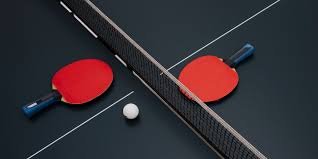
table tennis racket
Table tennis, or ping pong, is one of the most thrilling and fast-paced indoor sports. Whether you’re a beginner, an intermediate player, or a professional, choosing the right table tennis racket plays a critical role in enhancing your game. The racket influences several factors, including spin, speed, control, and overall performance. In this guide, we will break down the key components of a table tennis racket, discuss different types of rackets suited to various playing styles, and help you choose the best racket that matches your needs.
Components of a Table Tennis Racket
A typical table tennis racket consists of two main components: the blade and the rubber. Both parts are crucial in determining the racket’s performance, as they contribute to factors like speed, spin, and control. Understanding how they interact will give you better insights into selecting the right racket for your style.
1. Blade
The blade is the wooden part of the racket, and it plays a significant role in the overall feel, speed, and control of the racket. Blades are generally made of wood or composite materials, and their construction and design can drastically affect the performance of your racket.
Types of Blades
- Wooden Blades: Wooden blades are the most traditional and widely used. They offer a more flexible feel, giving players better control over their shots. Wooden blades are ideal for players who value precision and accuracy in their game. These blades are preferred by defensive players who focus on consistent rallies and return precision. You can learn more about the different types of blades here.
- Composite Blades: Composite blades are made with a combination of wood and materials like carbon, fiberglass, or kevlar. These blades provide a stiffer feel, making them ideal for offensive players who prioritize speed and power. Carbon blades offer better stability and control compared to purely wooden blades, making them excellent for generating faster shots.
Blade Features to Consider
- Speed: Players who prefer aggressive, fast play should opt for composite blades, which allow for greater speed. These blades are designed for players who rely on powerful attacks and quick returns. If you want to generate fast spin, composite blades work best.
- Control: If you’re a player who focuses on more precise, controlled shots, a wooden blade is more suited to your style. Wooden blades allow for better feel and forgiveness, particularly for beginners or players who prefer a defensive approach.
- Stiffness: Stiffer blades typically offer more speed but less control, while flexible blades provide better spin and accuracy but sacrifice some speed. Stiff blades are often favored by players focusing on attacking, while flexible blades work better for those who prefer a more controlled game.
2. Rubber
The rubber is the part of the racket that makes direct contact with the ball, and it plays a critical role in generating spin, speed, and control. There are two main types of rubbers used in table tennis rackets: inverted rubbers and pips-out rubbers.
Inverted Rubber
- Inverted rubbers are smooth, providing excellent spin capabilities. They are commonly used by intermediate and advanced players who focus on generating topspin, backspin, and other types of spin during rallies. The smooth surface provides a larger contact area for creating spin, which is essential for competitive play.
- Advantages: Inverted rubbers give more control and precision, making them ideal for players who prefer an attacking style with lots of spin.
Pips-out Rubber
- Pips-out rubbers feature small protruding pimples on the surface, which affect the spin and speed of the ball. Pips-out rubbers are used primarily by defensive players, as they help to reduce the amount of spin while providing a more unpredictable ball trajectory.
- Advantages: These rubbers are ideal for counter-hitting and block shots, where you want to neutralize your opponent’s spin and control the ball’s direction.
Rubber Thickness
The thickness of the rubber’s sponge beneath the top layer of rubber is a key factor affecting the racket’s speed and control. Thicker sponges generally provide more bounce and speed, whereas thinner sponges offer more control.
- Thicker Sponge: Provides more bounce and speed, making it ideal for players who favor attacking or fast-paced games.
- Thinner Sponge: Offers better control and precision, making it more suitable for defensive players.
For detailed information on how rubber thickness impacts performance, check here.
Choosing the Right Table Tennis Racket for Your Playing Style
When choosing a table tennis racket, it’s important to consider your playing style, skill level, and what type of game you prefer. Here’s a breakdown of which types of rackets are best suited for different styles of play:
1. Offensive Players
Offensive players rely on speed and power to dominate the game. For this type of playstyle, a composite blade with inverted rubber and a thicker sponge is ideal. This setup generates fast, aggressive shots and helps in creating heavy spin.
- Recommended Setup: A composite blade with inverted rubber and a thicker sponge.
- Advantages: High-speed shots with the ability to generate significant topspin, perfect for attacking play.
2. Defensive Players
Defensive players prioritize control and accuracy. For these players, a wooden blade combined with pips-out rubber and a thinner sponge provides better touch and the ability to return challenging shots with precision.
- Recommended Setup: A wooden blade with pips-out rubber and a thinner sponge.
- Advantages: Superior control and accuracy, ideal for defensive returns and counter-hitting.
3. All-round Players
All-round players need a balanced racket that offers a mix of both speed and control. A balanced blade with a medium-thickness sponge and inverted rubber is perfect for players who want to adapt to different styles of play while maintaining a good mix of spin, control, and power.
- Recommended Setup: A balanced blade with medium-thickness sponge and inverted rubber.
- Advantages: Versatile setup suitable for various playstyles, providing a balance of speed and control.
Top Brands for Table Tennis Rackets
Several brands are well-known for producing high-quality table tennis rackets that cater to different levels of players. Below are some of the top brands:
- STIGA: Known for producing premium rackets with top-quality rubbers and blades for players of all skill levels.
- Butterfly: Butterfly is a leading brand in professional table tennis, offering highly advanced rackets and rubbers.
- DHS: A Chinese brand known for its top-tier professional rackets, favored by many world-class players.
- Joola: Offers a range of high-performance rackets, from beginner to professional level.
Conclusion
Choosing the right table tennis racket is essential for improving your performance on the table. Your racket’s blade, rubber, and sponge thickness all play crucial roles in determining the speed, spin, and control of your game. Whether you’re an offensive player looking for speed, a defensive player seeking precision, or an all-rounder aiming for versatility, there’s a perfect racket for every playing style.
When purchasing a racket, consider your playing style, the features of the racket, and the brand that suits your needs. By selecting the right combination of blade, rubber, and sponge thickness, you can take your table tennis game to the next level.






